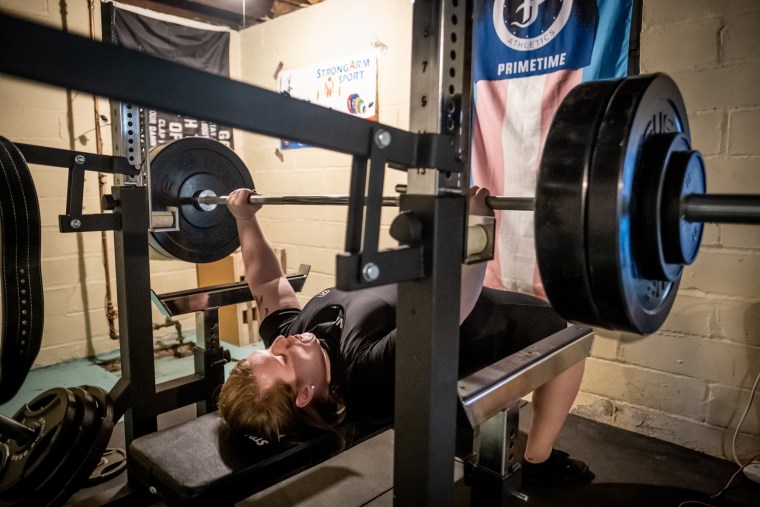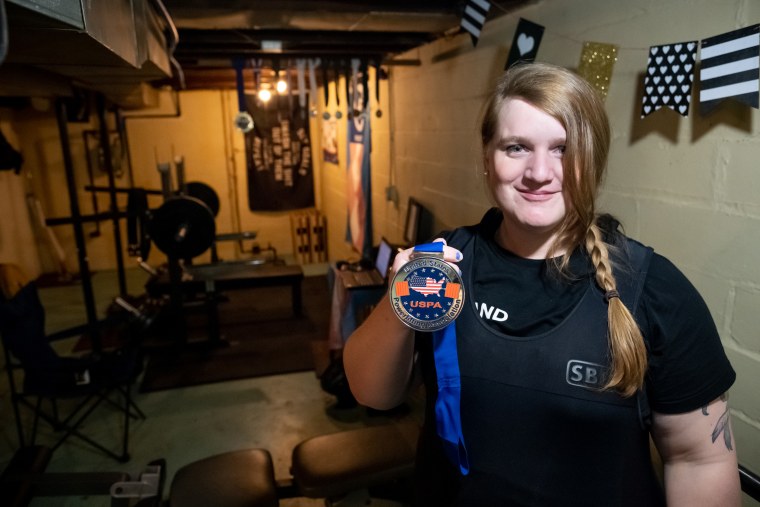A Transgender Powerlifter Fights for the Right to Compete
The first time JayCee Cooper walked out onto the platform at a women’s powerlifting competition, everything else fell away: her years-long internal struggle over her gender identity, her decision to leave men’s sports when she began transitioning, her doubts that she would ever feel safe if she returned to competitions.
When she stepped out in front of a hundred people in the gym in Fort Collins, Colorado, last September, all she focused on was the barbell, which she hoisted off the ground. And then she heard the cheers of the crowd: “Come on JayCee!” She had found not only a sport, but also a home.
“In a world that wants to take away our power and strength,” Cooper, 31, said recently by phone from her home in Minneapolis, “powerlifting is a way to gain that strength back and feel powerful and feel ownership of our own lives. It helps us find strength within ourselves and helps us find strength within our bodies.”
Cooper signed up for more competitions, but, to her astonishment, USA Powerlifting, the sport’s biggest federation, told her that she could not compete in the women’s division because of her gender identity.
In an email, USA Powerlifting said she was denied because she had a “direct competitive advantage” over the other women who were competing.
“It took me aback,” Cooper said. “I didn’t want to put myself into a situation where I obviously wasn’t welcome.”

Cooper’s story received national attention after she posted about it on Instagram in January. She drew support from fellow powerlifters and Rep. Ilhan Omar, D-Minn., who slammed the ban on transgender women competitors as “discriminatory” and “unscientific.”
It was just the latest in a growing number of battles over the place of transgender women athletes in competitive sports.
As transgender women have become more visible and sought to participate in women’s sports, athletic organizing bodies have grappled with how to respond, and critics of their inclusion have grown increasingly vocal, as well.
In March, tennis legend Martina Navratilova apologized for calling trans women “cheats” in a Sunday Times op-ed in which she wrote that “letting men compete as women simply if they change their name and take hormones is unfair.” Weeks later, marathoner Paula Radcliffe told BBC Sport that it would be “naive” not to institute rules. In an interview with Sky News in April, Radcliffe said that if trans people were permitted to compete without regulations, it would be “the death of women’s sport.”
Download the NBC News app for breaking news
For transgender people watching this issue play out, the debate — often based more in bias and assumptions than in science — is dehumanizing. Those who seek to exclude transgender women from sports sometimes imply that the athletes are adopting their identity to gain an edge in competition, a suggestion many find offensive.
Related
Trans athletes make great gains, yet resentment still flares
“They don’t understand what it means to be a trans person,” Chris Mosier, a competitive runner and cycler and the first known transgender athlete to make a men’s U.S. national team, said.
“The folks who are improperly reporting on this are making it seem like cis men are pretending to be women to dominate sports,” he added, referring to people who are assigned male at birth and identify as men. “I can say that the amount of discrimination, harassment and challenges trans people face in their everyday lives would never be offset by glory.”
‘IT’S BEEN A ROLLER-COASTER’
Before becoming a powerlifter, Cooper lifted weights as part of her training for other sports. As a teenager growing up in Clarkston, Michigan, she was on the U.S. junior national curling team, competed in track and field in high school and rowed in college.
But she never felt fully comfortable on those all-boys teams.
“It’s been a roller-coaster,” Cooper said. “One of the reasons I stepped away from curling was that I wasn’t being my authentic self, and I was super depressed, and I needed some time away to figure out what that meant for me.”
Four years ago, she began hormone replacement therapy as part of her transition. She now identifies as transfeminine, which she sees as a more expansive identity than simply female.
Cooper first came across powerlifting in high school, but didn’t decide to compete until last year while recuperating from a broken ankle, and she was struck by the sport’s simplicity and supportive atmosphere. In powerlifting, athletes are divided into categories by sex, age and weight, and they compete in three types of lifts: squat, bench press and deadlift. Each movement is a test of static strength, force and focus.

“The barbell for me has been a very empowering way to be in my body, which is politicized every waking second, connect with it, and feel like I’m achieving something,” Cooper said.
“It’s a very almost spiritual feeling in the sense that I’m carrying all of this trauma with me and I’m literally focusing all of that into the barbell. In that moment, I get to control what’s going on.”
To lower her testosterone levels, Cooper takes spironolactone, a drug that is also used to treat high blood pressure and can mask steroid use.
USA Powerlifting, which follows rules set by the World Anti-Doping Agency, requires athletes to apply for an exemption to compete while taking the drug. The group has granted exemptions to powerlifters who have taken spironolactone to treat acne or polycystic ovary syndrome, Larry Maile, USA Powerlifting’s president, said.
As part of her medication exemption application, Cooper provided documentation that her testosterone levels have remained under the International Olympic Committee’s accepted limit for two years. (USA Powerlifting falls under the International Powerlifting Federation, which adopted the IOC’s guidelines that allow transgender women to compete in women’s divisions provided their testosterone is below 10 nmol/L for at least 12 months.)
But in December, Cooper’s exemption request was denied. She was told she could not compete in the women’s division of powerlifting because she had a “competitive advantage” as a transgender woman, according to an email exchange obtained by NBC News between Cooper and Dr. Kristopher Hunt, the chair of USA Powerlifting’s committee that reviews applications for medical exemptions.
“Male-to-female transgenders are not allowed to compete as females in our static strength sport as it is a direct competitive advantage,” Hunt said in one email to Cooper.
Pressed for clarification, he wrote a follow-up. “The fact that transgender male to female individuals having gone through male puberty confer an unfair competitive advantage over non-transgender females,” he said.

In a phone interview, Maile defended the decision and said the organization’s policy of barring transgender women — as well as transgender men who take testosterone — was not new, though it was not posted on USA Powerlifting’s website until this winter after Cooper applied for the exemption. Maile said that the IOC’s guidelines ultimately give organizations the discretion to make their own decisions about fair play. To reach the decision, he said USA Powerlifting researched the physical differences between men and women in terms of muscle density, connective tissue and frame shape.
“We’ve been referred to as bigoted and transphobic and a whole lot of less kind things, but it’s not an issue of that for us,” Maile said. “It’s an issue that we have to consider dispassionately and make our best judgment collectively about what the impact on fair play is for us, and that’s the basis on which we’ve proceeded.”
He added that powerlifting “is really unique, because we’re a high strength and low technique sport” — so the physiology of the competitors is particularly important.
Cooper doesn’t buy that argument, noting that women’s bodies come in all shapes and sizes, which may confer advantages for different sports.
“You look at a WNBA player, they’re pushing 6 feet versus someone doing gymnastics who’s 5 feet tall,” she said. “Their bodies are built completely differently. That’s what sports are about.”
‘THE SCIENCE IS IN ITS INFANCY’
The policies governing transgender athletes vary by sport.
The NCAA has policies similar to the International Olympic Committee and does not require athletes to undergo gender-confirming surgery, while USA Gymnastics does require it under some circumstances, according to research compiled by TransAthlete, a database of professional, recreational, college and K-12 sports’ policies on trans athletes.
Others aim to be more inclusive. USA Hockey, for example, offers options for nonbinary athletes who do not identify as male or female, as well as guidance for trans athletes.
While opponents of inclusion point to the “bigger, faster, stronger” argument as the basis of their fear that transgender women are taking over women’s sports, there are few examples of trans women who’ve excelled at a national or world level, according to Cyd Zeigler, co-founder of OutSports, an outlet that reports on LGBTQ athletes.
Related
Bill targeting transgender athlete policy fails in South Dakota
The scientific research on transgender athletes is in the early stages, and there is disagreement among experts about how to determine fair rules of competitions.
“There’s no simple or even complex biological test you can apply that tells you who’s a man and who’s a woman,” Roger Pielke Jr., director of the Sports Governance Center at the University of Colorado, said.
In the absence of such a test, testosterone levels are often used as a proxy to determine whether trans women are eligible to compete in women’s leagues. There is evidence that transgender women who are on hormone therapy have lower muscle mass and less aerobic ability than they did before, said Joanna Harper, a scientist who studies gender-diverse athletes and advises the International Olympic Committee. In a 2015 study she published on trans women who are distance runners, Harper, who is a trans woman and runner herself, found that after being on hormone therapy the women were running more than 10 percent slower.
But testosterone is an imperfect metric. Even among cisgender men and women, there is variance in the amount that is considered normal.
To deny Cooper “the right to compete based on ridiculous fear is completely unfounded,” Harper said.
‘TRANS LIFTERS BELONG HERE’
At the Minnesota State Championship in February — a USA Powerlifting meet where Cooper hoped to compete — almost a dozen athletes and 20 people in the audience protested her exclusion, according to Maxwell Poessnecker, a transmasculine-identified lifter from Saint Paul, Minnesota. Flanked by signs and wearing T-shirts that said, “I support trans lifters” and “trans lifters belong here,” the athletes stood on the lifting platform without competing to show their disapproval of the policy, Poessnecker said.
From little leagues to the Olympics, questions over transgender inclusion will continue to surface. Advocates who say concerns about “competitive fairness” are often rooted in gender stereotypes and scientific research is lacking believe policies should be as inclusive as possible.
“It’s hard to call anything model when it requires an individual to be tested and questioned,” said Breanna Diaz, a powerlifter and co-director of Pull for Pride, a charity deadlifting event that benefits homeless LGBTQ youth. If athletes “have a sincerely held gender identity, that should be sufficient,” she said.
Cooper, who co-directs Pull for Pride, hopes to use her experience with powerlifting as a way to drive the conversation about trans athletes.
On May 9, USA Powerlifting’s national governing body will meet to discuss its transgender inclusion policy.
“I really do love this sport,” Cooper said, “and it’s not fair to genetically eliminate an entire group of people.”